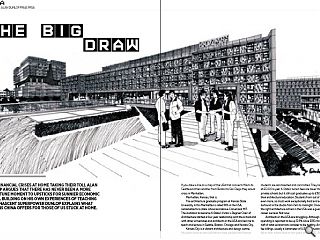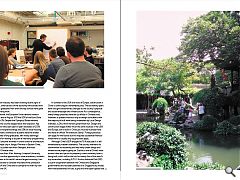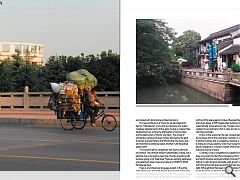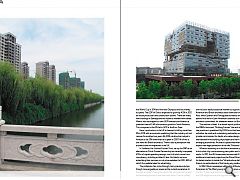Working in China
25 Oct 2012
With financial crises at home taking their toll Alan Dunlop argues that there has never been a more opportune moment to up sticks for sunnier economic climes. Building on his own experiences of teaching in the nascent superpower Dunlop explains what lessons China offers for those of us stuck at home.
If you draw a line on a map of the USA that connects Miami to Seattle and then another from Boston to San Diego they would cross in Manhattan.Manhattan, Kansas, that is.
The architecture graduate program at Kansas State University in this Manhattan is rated fifth in the USA, remarkable for a state school and above Cornell and MIT. The invitation to become K-State’s Victor L Regnier Chair of Architecture started a four year relationship with the school and with other universities and architects in the USA and led me to teach and lecture in Seattle, Boston, Chicago and Kansas City.
Kansas City is a vibrant architecture and design centre. My public lectures and exhibitions were packed and Kansan students are also talented and committed. They have to be, at £5,000 a year K-State’s tuition fees are lower than the top private schools but it still cost graduates up to £150,000 for their architectural education. Students from out of state pay even more, so most work exceptionally hard and are often to be found in the studio from 7am to midnight. Once, getting into the right architecture school in the USA was a guarantee to career success. Not now.
Architects in the USA are struggling. Although construction spending is reported to be up 12.9% since 2010, this is roughly half of what economists consider to be healthy. Architect fee billings, usually a barometer of U.S. construction activity, fell to their lowest level in two years in May 2012. Although the construction industry has been showing recent signs of improvement, other sectors of the economy have slowed with the result that graduates from even the top schools have great difficulty in finding work.
Closer to home, the European Union remains mired in financial crisis and in August 2012 the GDP of the Euro-Zone fell by another 2%. Despite the Olympics, Britain remains depressed as the country slipped back into recession. Key building sectors have seen year on year decreases of 21.5% on schools and hospital buildings and 23% on social housing. Outside of London, architecture students have the lowest employment rate of any graduates, with many seemingly willing to work for nothing or as part of internship programmes.
Recently, I became involved in a new school of architecture in Suzhou, a major city in Jiangsu Province in Eastern China, forty minutes by bullet train from Shanghai, the most “European” of Chinese cities.
The invitation from Xi’an Jiaotong-Liverpool University (XJTLU) gave me the opportunity to meet academics, students and practitioners in the world’s second largest economy. I am privileged to be able to consider the state of the profession in both the USA and China and to compare this with my own experience in the UK.
In contrast to the USA and most of Europe, construction in China is continuing at a remarkable pace. The last twenty years have brought extraordinary changes to the country’s physical and social landscape and infrastructure. As a consequence, many foreign practices have set up offices in Chinese cities. However, at present most act only as design consultants with the majority of built work being undertaken by Local Design Institutes, (LDI’s) which remain government run. Design and construction stages follow much the same route as in the USA and Europe, but to build in China you must be licensed there and have an official “Architecture Stamp”.
Foreign practices can apply for the license but this requires substantial financial investment so usually only big practices apply.
Although China’s GDP dropped to 7.6 % last year, it is still remarkable by western standards. The country maintains its commitment to modernity and has many urban design and infrastructure projects going on. Suzhou is one of China’s most ancient cities and yet on its periphery a new university town is being built, which will be the hub for twenty five of the world’s top universities, including XJTLU. Suzhou Industrial Park (SIP) is a joint cooperation between the Chinese and Singapore governments and has been planned on a Singapore city model, with wide boulevards for cars, a grid and wide open spaces that are marked with stand alone architectural icons.
The new architecture of China can be described at its best as “international” or at worst as massively over scaled “prestige” developments of blue glass, bronze or copper. New development can involve the atomisation of communities and the destruction of historic city fabric. The school of architecture campus has been master-planned by the giant American practice Perkins and Will and the new library and administration building by Aedas, another multi-disciplined global outfit.
The industrial park’s comparison with Suzhou old town are marked. The old town remains authentically Chinese, not a pastiche, but a city built up over time. The city is bustling with business going on at street level. There are working waterways and pedestrian areas, shops and cafes and UNESCO World Heritage gardens.
There is an architectural language evident in the white walls, black eaves and roofs. People live and work in the same area and the buildings are predominantly three and four storeys high and of human scale. Yet, although all the clues are there, nothing of this place seems to have influenced the architecture and urban design of SIP. Instead older buildings have been systematically removed and a new “modern environment” created. An environment which is clean and air conditioned but charmless and alien.
In fact, to the newcomer the new campus feels like it could be anywhere and at this point lacks character. It was created to attract business and is succeeding. However, it comes close to losing its Chinese identity. China must surely face decisions about competing in a modern market whilst trying to retain its culture and sense of place.
Currently, China’s competition as a global economic power does not come from the USA or Europe but from South Korea and South America, particularly Brazil, Chile and Mexico. Most nations in Latin America anticipate solid growth, as they have built strong financial reserves and limited their levels of public debt. Although Brazil has been impacted harder than any other South American countries by the slowing in demand for its commodities from China, architecture jobs are now being filled by Europeans from Spain and Portugal. Brazil is preparing for the World Cup in 2014 and the next Olympics and has money to spend. The GDP of Chile is expected to grow by 4.5% in 2013 as house prices soar and construction booms. There are many new buildings in Santiago and its skyline is marked with cranes. Mexico has outstripped its own GDP forecasts and there is a predicted rate of 3.4% of economic growth in South America. This compares to the 2% fall in GDP in the Euro Zone.
Here, construction in the UK is forecast to fall by more than 5% in 2013 with economists predicting that the industry will not recover for another two years. By 2015 construction output is forecast to be 12% lower than at its peak in 2007. All of this is dire news for British architects. There is also a perception that architects are not respected in the UK.
In Scotland, the Scottish Futures Trust, set up the SNP as an alternative to Public Private Partnership has recently trumpeted £131m of capital spending savings, much of which came from consultancy, including architect’s fees. Architects are now advertising their services on cut price websites for £120, £60 of which the website takes for advertising.
The profession has come through many previous slumps, though none arguably as severe as the current experience. In the past, architects have gone where the work was and people are now being forced to cast their nets wider. China is unlikely ever to be an easily accessible market but opportunities for American and British architects exist there and throughout Asia, whilst Spanish and Portuguese architects seem to be able to find work in Latin American countries but what about architects committed, for whatever reason, to Britain?
The outlook is bleak. In a recent report published by the RIBA’s think tank “Building Futures” the end of medium size practices is predicted. By 2025 firms that have survived will either be small and undertaking restoration work or private commissions for clients who value design or be large international firms building skyscrapers and new cities in the emerging economies. Architects questioned even say that they expect their legal protection of the title “Architect” will be gone.
When an economy is in decline an economic philosophy is to kick start it by commissioning new public and infrastructure works. In 2011, the UK Government announced £1 billion of additional investment projects as the Prime Minister made clear his determination to tackle the “infrastructure deficit”. In 2012, there is no real evidence of this having any positive effect.
In 1852, Illinois newspaper editor John B Soule advised Americans to “Go West young man … and grow up with the country” Today, sage advice to young architects in Britain and the USA might be to do the opposite and go east.
|
|
Read next: Rediscovering lanes and backcourts
Read previous: Carbuncle Awards 2012
Back to October 2012
Browse Features Archive
Search
News
For more news from the industry visit our News section.
Features & Reports
For more information from the industry visit our Features & Reports section.






